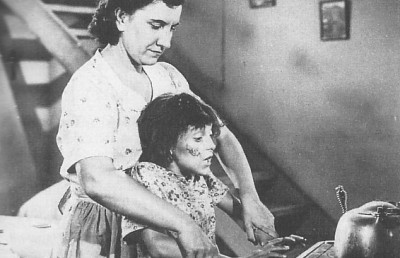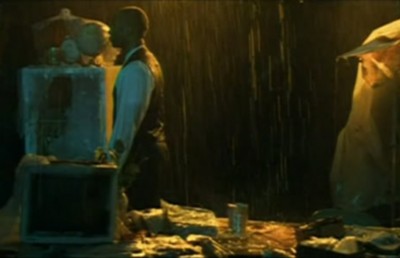Double O-Canada: Decoding IXE-13 from Page to Screen
Jacques Godbout's Québécois Classic

The explosive cleavage and smoking gun barrels that leapt like gangbusters from post-war newsstands had an immediate, visceral appeal for pulp magazine readers, but often what lay behind the lavishly illustrated covers was just as remarkable. The cheaply printed pulps were crammed full of stories that played on the day’s most nagging societal anxieties—splitting the atom, foreign infiltrators, and the unpredictable nature of crime and violence. Although the pulp industry was predominantly controlled by American publishing houses, Canada managed its own brief take on this form of lowbrow literature, and in pulp’s golden age, dropping some pocket change at a Montréal bus station was all it would take to pick up the latest “roman feuilleton” (serial novel). Written, illustrated and printed in Québec, these 32-page booklets encompassed the thrilling sub-literary genres of romance, science fiction, crime and espionage, all with indigenous settings and protagonists. Despite fierce competition, a charismatic super spy named IXE-13 outlasted all his pulp contemporaries to become a phenomenon in French-Canadian popular culture. Eager fans snapped up more than 28 million copies of his long-running series Les Aventures Etranges de L’Agent IXE-13 (The Strange Adventures of Agent IXE-13), creating a legacy that culminated in a 1971 film adaptation that played up the infamous character’s camp appeal.
Much as Québec director Jacques Godbout’s tongue-in-cheek film version of IXE-13 challenged the cultural grain when it debuted in the early 1970s, pulps and dime novels did the same when they reached their crest of popularity in the late 1930s and early 1940s. During this time, Canada’s cultural elite were meticulously cultivating a tradition of staunch realism. Robert Stead and Frederick Philip Grove’s social morality plays and bleak portraits of rural life had dominated Canadian literary fiction since the 1920s, while the newly-formed National Film Board of Canada (NFB) produced optimistic but cheerless wartime propaganda, travelogues and nature documentaries. Portrayals of rugged heroism in the frozen tundra of the north were the sole property of Mountie pulps (and later, Mountie films), but even here, Canada was little more than a convenient, exotic setting. With few exceptions, magazines like Real Northwest Adventures were written and published by Americans who clung to the romantic image of Canada as a wooded Eden of untamed wildlife, “Indian” trading posts and French-Canadian lumberjacks.
All that changed with the passing of 1940’s War Exchange Conservation Act, a trade barrier that prohibited “non essential” purchases including comic books and pulp magazines, which left Canadian publishers scrambling to fill holes on newsstands. While many of the English-Canadian pulps managed to slip through by simply reprinting American stories, some publishers recognized that offering material with a local flavour might hold more interest for their readers. The stoic Mounties were forced to relinquish their dominance of the fictional landscape, as writers introduced levelheaded detectives, spies and scientists that lived and worked in the same cities as their inky-fingered fans.
Once World War II ended, so did the embargo, and the generally poor quality English-Canadian pulps disappeared under an avalanche of readmitted American magazines. Protected by the language barrier, the roman feuilletons of Québec became the sole remaining source of Canadian pulp, led by a virtual army of fictional French-Canadian flatfoots like Sergeant Colette, Inspector Robert Leroux and Simon Legrand. One of the more popular detective booklets was Fameux détective exploits du merveilleux détective Jean Lecoq, written by popular Radio-Canada personality Pierre Daignault under the pseudonym Pierre Saurel. With _Lecoq_’s 1943 debut, Daignault quickly became one of Québec’s most prolific roman feuilleton writers, penning thousands of stories of unlikely Canadian heroism. In 1947, Daignault gave up on Jean Lecoq to concentrate on a new secret agent character, IXE-13, advertised as “L’As des Espions Canadiens” [“The Ace of the Canadian Spies”].
In many respects, Daignault’s stories were indistinguishable from his American and British contemporaries. Like most pulp fiction, Les Aventures Etranges de L’Agent IXE-13 was written in short, punchy sentences and featured concise chapters that usually ended with a cliffhanger. Although the Aventures hit many of the same societal hot buttons as its American contemporaries—exploiting continent-wide uncertainties of war and conflicting ideologies—this roman feuilleton also catered to issues specific to the book’s Québécois readership. The garish, one-colour cover that adorns the premiere issue of Les Aventures Etranges de L’Agent IXE-13 gives way to the story of young Jean Thibault, a well-traveled French-Canadian athlete and scholar who abandons a promising tennis career to study aeronautics, and submarine design. With the outbreak of World War II, Thibault joins the Canadian secret service and receives the codename IXE-13. His first field assignment, “Le repaire de la mort” [“The Den of Death”], has the young spy sent to a Nazi submarine base to rescue his future fiancée, French secret agent Gisèle Duboeuf, with the help of Marius Lamouche, Gisèle’s slightly more unrefined colleague.
The initial installments of the series employed as much realism as the spy genre would allow, with a distinct military flavour that found its way into the stories through technical details and a wartime setting—fine points that would have appealed to veterans recently back from their own service overseas. But as the spectre of the war diminished and IXE-13 was brought up-to-date in a postwar setting, his adventures took on a distinct comic book tone. Brazen titles like “Nazis à Ottawa!” [“Nazis in Ottawa”], “Sous-marin au Labrador” [“Submarine in Labrador”] and the far-fetched “Hitler au Canada” [“Hitler in Canada”] certainly would have turned the heads of Québec commuters when positioned alongside more commonplace detective pulps. The series also soon gave way to more distinct villains, including a facially disfigured fascist named Von Tracht who was more interested in his own plans for world domination than in serving the Nazi party.
Already six years old when Ian Fleming’s immensely popular 1953 novel Casino Royale sent shockwaves through the spy fiction genre, IXE-13 was ushered into a sophisticated Cold War setting by his British colleague, James Bond. Although Nazis continued to make appearances in the booklets, a new set of Communist enemies were inducted into IXE-13’s rogue gallery, including Red spies Bourof and Tracko, and ultimately, the French-Canadian spy’s most dangerous adversary—Taya, the “Queen of the Chinese Communists.” Adding a female villain allowed Daignault to take his stories in a different direction—in between devising evil plots for the conquest of Canada and the whole of North America, Taya took a personal interest in the handsome French-Canadian secret agent. Moving IXE-13’s undercover work from the battlefield to the bedroom—although strictly through implication—represented a fresh challenge for the young spy to remain true to both his country and his new fiancée Gisèle, who patiently waited for their impending wedding, despite persistent delays.
Like many Québécois, IXE-13 straddled the Atlantic in an attempt to balance the new technologically-charged Western world with the traditions and culture of Europe, but of all the elements that made the young spy such a distinctly Canadian creation, it was not what IXE-13 did, but what he could not do that would have impressed his readers. As likely the only international secret agent bound to the devout Catholic morality that characterized Québec at the time, IXE-13’s ability to operate as a traditional pulp fiction spy with a girl on each arm and a deadly weapon concealed in his tuxedo jacket was severely limited. To avoid extended post-mission sessions in the confessional box, IXE-13 used his resourcefulness to complete assignments, leaving any objectionable violence or bloodshed to the more broadly-drawn Frenchman, Marius Lamouche. Keeping IXE-13’s love life inoffensive also presented a problem, especially since vaguely-depicted sex was the primary selling point for most pulps. Daignault usually kept his spy unconscious of any sexual indiscretion through enemy mind control, hypnosis, or some other fiendish scientific breakthrough. In this way, the author could absolve IXE-13—and by extension his readership—of enjoying any illicit liaisons.
American pulps were almost a distant memory by the 1960s, but Les Aventures Etranges de L’Agent IXE-13 continued to mine new societal anxieties in order to stay relevant. As the American-Soviet space race heated up, Daignault incorporated a science fiction angle, which took the Canadian spy to faraway worlds in adventures titled “La planète mystère” [“The Mystery Planet”] and “Les vampires de l’espace” [“The Space Vampires”]. As the decade came to a close, the character was even reborn in IXE-13, l’Espion Playboy (IXE-13, The Playboy Spy), a risqué new series that dropped any pretense of religious morality. This time, Gisèle, and Marius’ Canadian wife, Roxanne, were nowhere to be found, and as newly confirmed bachelors, the male heroes were free to delve into Montréal’s underworld of sex and drugs without repercussions. Despite lurid titles like “IXE-13 et les call-girls” [“IXE-13 and the Call-Girls”], “Orgies à la chinoise” [“Chinese Orgies”] and “Camp de nudists” [“The Nudist Camp”], this series represented one of the last gasps of IXE-13 and the roman feuilletons as a whole. Even having the super spy visit Expo ’67 in “Espionnage à l’Expo” did not propel the new series farther than a 20-issue run.
As film and television usurped the throne of pulp magazines as the preferred source for cheap, melodramatic entertainment, many pulp characters migrated to the big screen. Well-known protagonists like Charlie Chan, Dr. Fu Manchu and James Bond began to make the leap to celluloid as early as the 1930s, proving that the essential appeal of the characters was timeless, even if their parent periodicals were not. Although it seems unlikely that a French-Canadian spy would be called upon to follow in the noble footsteps of such industry giants, that’s just what happened when Godbout gave his boyhood hero a new lease on life by both reinventing and spoofing IXE-13 for a modern, film-going Québec audience.
Nineteen seventy-one was a watershed year for Canadian film, a time when government support had finally come through for the industry and an identifiable style of realism had begun to emerge. In the same year that critics applauded Pete and Joey’s coast to coast misfortune in Goin’ Down the Road (1971, Don Shebib), IXE-13 made his own Nazi-busting screen debut with machine-guns blazing, scantily-clad girls swooning, and choreographed musical numbers. Starring the members of “Les Cyniques,” a popular Québec sketch comedy troupe, and local musicians Carole Laure and Louise Forestier, the film pits IXE-13 (André Dubois) against Taya (Louise Forestier) and Von Tracht (Marc Laurendeau), while he solves the mystery surrounding the assassination of a wrestler named Bob West. To say that the colourful, over-the-top musical farce of Godbout’s IXE-13 was out of step with the prevailing film culture would be a gross understatement, especially considering that it was produced by the usually sober NFB.
What’s most striking about IXE-13 is its balls-to-the-wall satire. While not the first Canadian film to gently skewer pop culture—that distinction belongs to the Toronto-lensed horror spoof Flick (1970, Gil W. Taylor)— IXE-13 turns a gently mocking eye back towards the Great White North, anticipating later self-reflexive Canuck spoofs like Crime Wave (1985, John Paizs) and Big Meat Eater (1981, Chris Windsor). First and foremost, IXE-13 affectionately pokes fun at many of the familiar clichés and convenient plot devices that featured prominently in Les Aventures Etranges de L’Agent IXE-13. All of the series’ well-loved characters are exaggerated to ridiculous proportions. Sporting a striped shirt, a beret and an absurd mustache, Cynique Marcel Saint-Germain’s portrayal of Marius Lamouche is an hilarious jab at the corny French characters in the book, while in his nighttime attire of a Montréal Canadiens jersey and fleur-de-lis boxer shorts, IXE-13 becomes an absurdly patriotic figure that would make even Bonhomme Carnaval blush a few shades of red deeper than his sash. IXE-13 also never misses an opportunity to have its characters trick each other with a variety of disguises, a device that figured prominently in the series. Here, however, IXE-13 always fails to notice the large, telling scar on Von Tracht’s cheek, no matter how many times they meet incognito. Fans of IXE-13’s adventures in the roman feuilletons would have especially appreciated the film’s climax, in which IXE-13 is hypnotized by the evil Chinese temptress Taya for a special assignment—as well as a night of passion.
Some of the sardonic humour can no doubt be attributed to the involvement of Les Cyniques, but Godbout, one-time head of the NFB’s French production division, takes the lampooning of Canadian culture a few steps farther. Although the intentionally obvious model work and crudely painted white pasteboard sets only serve to highlight IXE-13??’s miniscule budget, the addition of an omniscient narrator, snippets of animation and even a few brief scenes from a dull NFB nature short, ??Au Parc Lafontaine (1947, Pierre Petel), all which gleefully ape the stuffy conventions of Canadian film, make IXE-13 as much a satire of the industry as of the Québec pulps.
Where Daignault appealed to his audience by exploiting contemporary concerns over Cold War politics, Godbout drags his characters into the turbulent wake of Québec’s Quiet Revolution. Jean Lesage’s Liberal government, elected into office in 1960 shortly after the death of premier Marcel Duplessis, had taken the first steps to wrest control of the province’s social services from the Catholic Church, sparking notions of political sovereignty. As Québec evolved beyond the strict morality of Catholicism, the province’s film industry also underwent a renewal, and a new breed of politely sexy French-Canadian comedies including Valèrie (1968, Denis Héroux) and Deux femmes en or (1971, Claude Fournier)—dubbed “maple syrup porn” by the pundits at _Variety_—were released that slyly poked fun at the cultural influence of the Church. In this spirit, IXE-13 actually begins with a send-up of the Catholic Church’s condemnation of the roman feuilletons, as a priest (Serge Grenier) waves one of IXE-13’s booklets before his congregation and warns the boys in his parish to stop spending their dimes on lurid serial adventures. Later, at the very height of the film’s calculated ridiculousness, IXE-13 uses his rosary to attack a mysterious figure hidden in the shadows.
As their name implies, however, the maple syrup porn films didn’t break province-wide box-office records because of their underlying sociological commentary. Valèrie and Deux femmes en or equated Québec’s newfound sense of identity and freedom with the current sexual revolution, and audiences flocked to the films to witness guiltless nudity that had previously been banned under the Catholic Church-controlled Le Bureau de Censure, only recently replaced by a system of film classification. IXE-13 may only feature a few flashes of seat-filling nudity, but the newfound freedom of expression allowed Godbout to target the repressed sexuality of the books. The lust-charged scenes that put IXE-13 in the arms of Taya, as well as a female taxicab driver, are directly contrasted with the idyllic, laughably tame affection the spy shows towards Gisèle, who is eventually left at the altar by Canada’s hardest working spy when duty calls—again. This is made all the more poignant by the fact that Louise Forestier plays the double role of Taya and Gisèle. Audiences, especially those that may have been longtime readers of the series, no doubt would have responded with both their approval and their wallets to Godbout’s sly acknowledgement of the limitations of the pulps, juxtaposed with Québec’s postwar cultural climate.
As demonstrated by IXE-13’s evolution through the 20th Century, the garishly-coloured funhouse mirror of mass culture can often reflect a nation’s fears, desires and self-image in a wholly different way than a country’s critically approved artistic output. By remaining responsive to and reflective of his evolving audience, Daignault’s Les Aventures Etranges de L’Agent IXE-13 provided a thrilling alternative to the stark prairie realism of Canada’s mid-20th Century literature, just as Godbout helped celebrate the Quiet Revolution by reinventing the classic character for hipper, sexually liberated viewers.
More importantly, however, Daignault offered a distinctly Canadian interpretation of a cultural industry largely dominated by American interests, and effectively broke the concept of “Canadian heroism” free from the Northwoods Mountie stereotype. Despite adopting an occasionally mocking tone, Godbout’s IXE-13 showed genuine respect for the character, and pushed the gentleman spy’s influence beyond the printed page to cement the character as a true national icon. This is what makes Godbout’s film a truly remarkable entry in the Canadian film canon—it firmly reclaimed our popular culture from our American neighbours using a known character with a pre-existing, distinctly Canadian mythology. Although Godbout’s IXE-13 is often bypassed on lists of the top Canadian films of all time, as a unique cultural artifact and a lost part of our national pop history, few homegrown films are more intriguing. The Ace of the Canadian Spies’ motion picture debut effectively caps off an amazing legacy in Canuck pulp storytelling.













